Vending machines selling school girl's panties? Grown men reading pornographic comics in public? Gender segregated train-cars to protect women from gropers? Ear-cleaning parlors with very happy-endings? With situations like these making headlines, it comes as no surprise that Japan has earned a reputation for perverted culture.
My first foray into the world of anime left me with a similar impression. At that time, action, comedy, and even children's anime vhs tapes shared shelf-space with hentai titles. I'd feel embarrassed looking past cartoon breasts and butts big enough to make Sir MixALot blush to find what I wanted. Finally I'd spot Goku throwing a fireball next to a sailor-suited girl being molested by aliens, an R-18 sticker (un)cleverly affixed over her private bits.
Although Japan might get a raw deal when it comes to perversion, it's not a recent development. In fact, Japan has a long, rich history of erotic images. The roots of pornographic manga and anime can be traced all the way back to the Edo era, during the shunga (or erotic woodblock printing) boom.
Recent lifts on shunga bans have opened the floodgates, allowing greater understand of the true meaning, uses, themes, and lasting impact of shunga. But recent exhibits have refueled an age-old debate – what separates art from obscenity?
What Are Shunga?
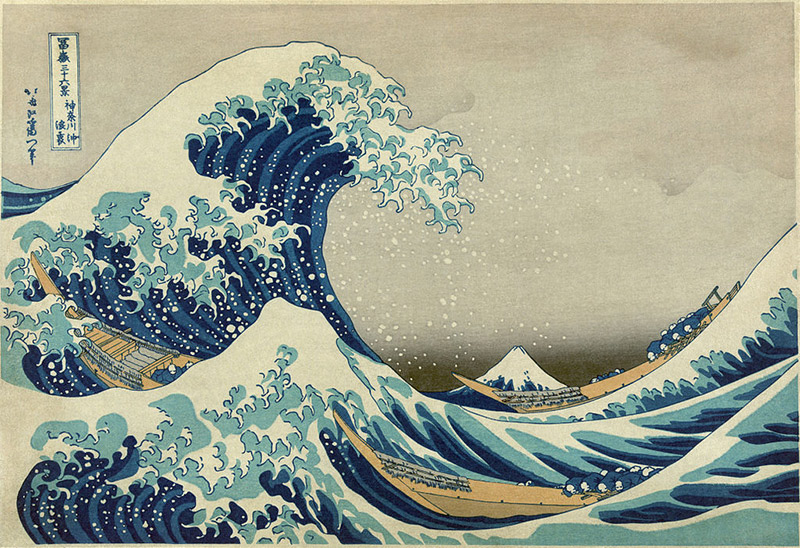
The term shunga 春画 literally translates into "spring picture" but has little to do with the season, describing erotic prints that gained popularity during the Edo era. Examples of shunga range from subtle adult situations to grossly – in both senses of the word – explicit imagery, and cover an array of subjects and themes.
Although shunga originated during the Heian period (794 to 1192 A.D.), a lack of technology made copying images painstaking and expensive. As a result only the upper-classes had the luxury of owning pieces of art, shunga or otherwise.
The Edo era (1603 and 1868) saw the advent of woodblock printing which allowed for the mass production of quality images. Through this technique artists carved images into wooden blocks which were coated with ink and pressed onto paper, leaving a print. As technology improved, the mass production of images lead to greater availability, lower prices and therefore wider distribution of prints.

Chances are you have already seen what many consider the world's most famous woodblock print in The Great Wave by Hokusai. It may come as a surprise that such a renowned artist also gained notoriety for pornography. Many famous woodblock artists dabbled in shunga and Hokusai is no exception.
However artists weren't in search of notoriety. Tim Clark, curator of a shunga exhibition at The British Museum explains, "We can be pretty sure that everybody in Japanese society, from the ruling class down to the ordinary townsperson used and enjoyed shunga." High demand for erotic prints meant shunga outsold other genres and artists simply migrated to the most profitable market.
Edo, the capital city at the time, became the shunga boom's epicenter. In Masterclass: Understanding Shunga: A Guide to Japanese Erotic Art Majella Munro writes, "No indulgence or pleasure was unavailable within (Edo's) precincts… from brothels to… huge quantities of porn, guidebooks, and other marketing paraphernalia"(p13).
Of course the images drove shunga's popularity. In his book Sex and the Floating World, Timon Screech explains, "Shunga… are rarely stories, and in most instances a page can reasonably stand alone." The scarcity of narrative driven shunga suggests plot took low priority on shunga customers' lists.
Shunga's Uses
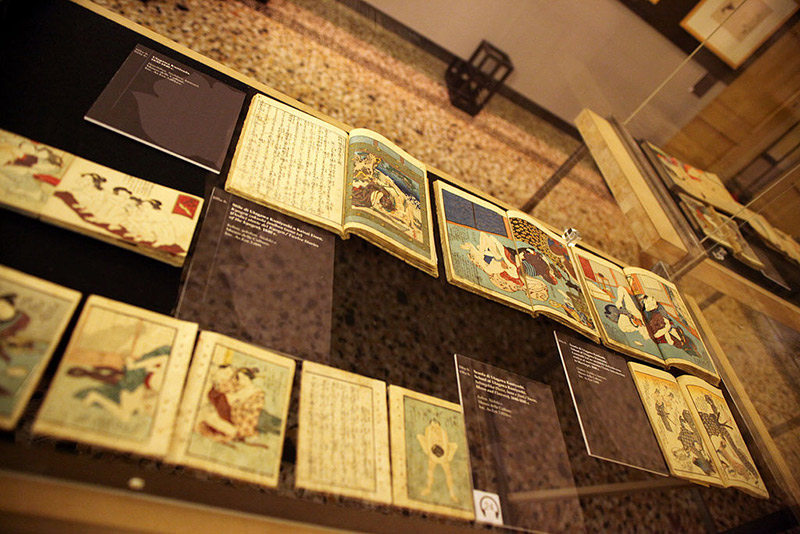
Why did Edo-era people buy shunga? In Sex and the Floating World, Timon Screech gives the topic thorough investigation and the reasons range from the logical to the absurd.
Let's start with the absurd – some shunga owners believed the erotic prints brought good luck. Warriors carried the prints, convinced they warded off death. In a sword carrying culture forged in the deadly violence of war, a society that continues to buy protection amulets today (probably of the non-erotic variety, though I've never opened one to find out), people tried anything to escape death's cold grip.
As if that weren't enough, shunga were also rumored to prevent fires. Ota Nanpo, one shunga owner wrote, "If you collect these types of book, you will save yourself from destruction by fire" (Screech). Combustable building materials and the use of fire as a source of heat and light made fires a constant problem in ancient Japan. In a time predating fire insurance, responsible homeowners bought the next best thing – shunga.
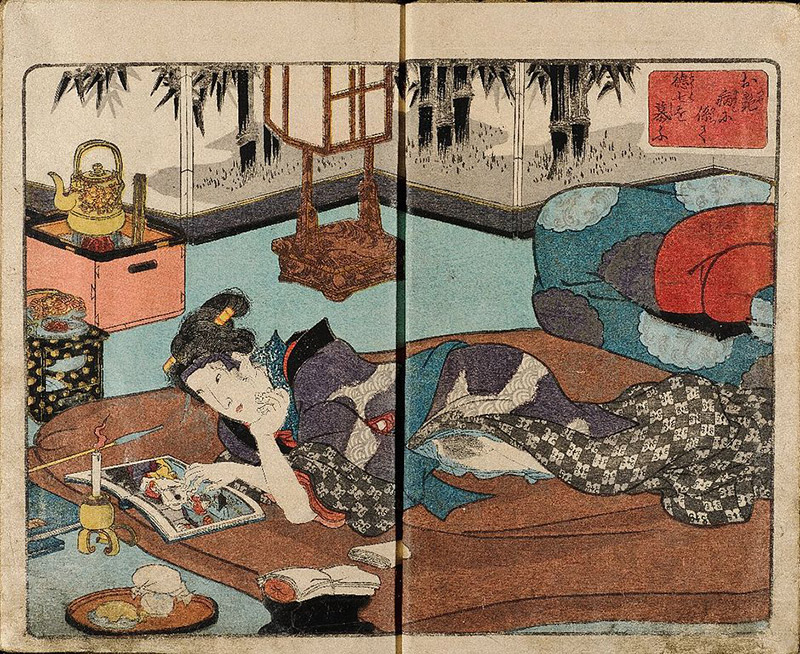
One logical claim is that some owners used shunga as sexual guidebooks. Luke Malone of vocative explains, "More detailed shunga were often used as sex guides and given as gifts to children from wealthy families." The erotic prints made perfect educational gifts for young people unpracticed in the arts of pleasure or old dogs looking to learn new tricks.
However, Screech believes the most common reason behind shunga's widespread ownership and popularity is also the most obvious – the prints served as a source of self-pleasure. He writes, "Erotica were intended for those who, as a result of constraints of time or finance, or their ethical stance, were unable to go (to the pleasure districts) often."
It's no coincidence that Edo, a "City of Bachelors" became the center of printing during the shunga boom. Tokugawa law, which separated husbands from their wives and lovers, helped justify and popularize the ownership and use of shunga among both sexes. Travel was difficult, couples could go months without reuniting.
Shunga helped separated couples pass the time (wink, wink) and provided a cheap and reusable alternative to the expensive red-light districts and pleasure quarters. Screech writes, "Shunga ownership might be excused as only for interim use until the next authentic bout (of sex)."
Shunga's Themes
Good Old-Fashioned Love
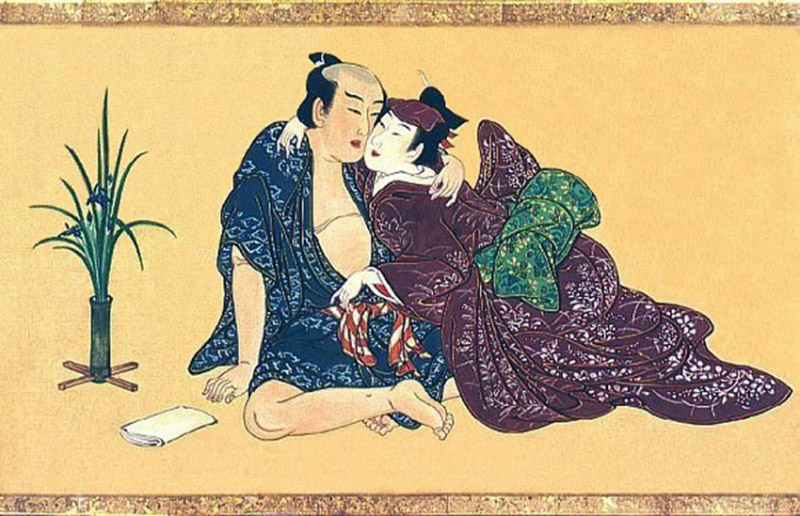
Despite what those anime vhs covers of my youth led me to expect, most shunga depict affectionate love-making. Ruth Styles of Dailymail.co.uk writes, "Most of the images, although explicit, are loving – even tender – and show the pleasure being shared out between men and women in equal measure."
With Japan's reputation for perversion, the affection these prints depict may come as a surprise. Most shunga depict physical love between husbands and wives – or at least consenting adults. But these tame depictions take a backseat to the striking, memorable impressions left by the less frequent, but more extreme shunga.
Fashion's Finest
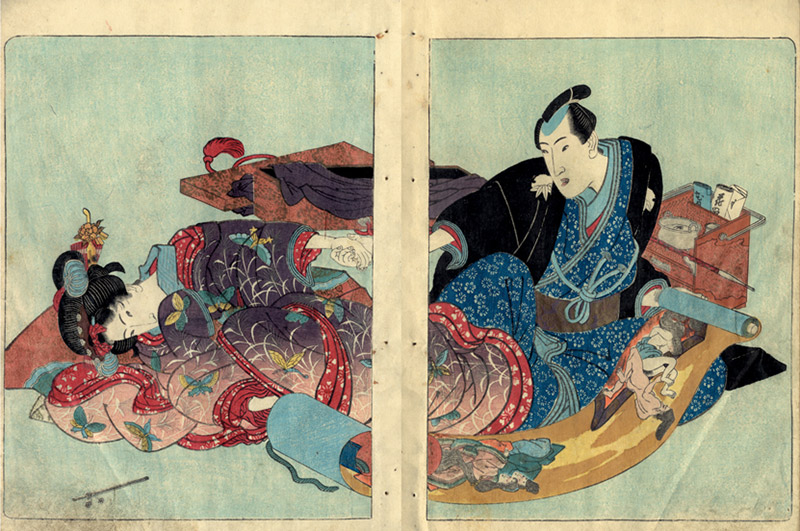
Today's viewers might assume the throes of passion left little time to undress, as many of shunga's subjects remain fully clothed. But at the time, flashy attire flaunted wealth and gained popularity with prostitutes and actors, giving fashion a "sexual power" that made it a shunga staple (Screech). Japanvisitor writes, "It was the fine silks and sumptuous clothes of the geisha that made them the stuff of men's dreams." Partially clothed bodies proved to be more provocative than the fully nude, so most shunga feature partially or even fully clothed subjects.
Homoerotic Over and Undertones

Heterosexual couples represented the norm in shunga, but they weren't the rule. Screech points out that during the Edo period, "'heterosexual' and 'homosexual' were not fixed, distinct human types, rather they were understood as activities."
Furthermore, nanshoku, or "traditional male love," remained an enduring facet of Japanese society and Japan accepted homoerotic themes that would have otherwise been been dismissed as immoral by most Western culture at the time.
Gender Ambiguities
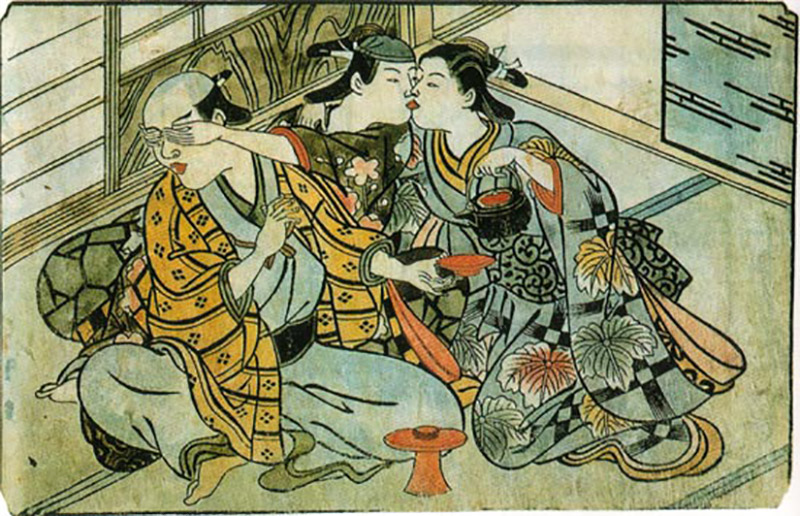
Shunga's art style makes differentiating the sexes no easy task. "In shunga, male and female bodies appear virtually identical other than the genitals" (Screech). The differentiation of Shunga's male and female faces and bodies is made even more difficult by the subjects' ambiguous, tumbleweed-like bodily entanglements.
The prominence of fashion added to the confusion. Worn by both sexes, kimonos tended to hide bodily features and add to shunga's rampant gender ambiguities.
To further complicate matters, cross-dressing actors and prostitutes also made their way into shunga. Screech points out, "Indeed, Westerners routinely mistook the attractive boys (wakashu) for girls, as do many modern viewers."
Onstage, adolescent boys played girl's roles with great feminine effect. As evidence of nanshoku's popularity, "boy prostitutes of the Edo period commonly dressed as girls" (Screech). Shunga's style and the era's attitudes rendered gender identification in shunga difficult and ultimately unimportant.
The Depiction of Genitalia
Yet shunga provide an easy way (or should it be two easy ways?) to discern gender ambiguities through their depiction of male and female genitalia. Many shunga feature shocking, at times grotesquely enlarged genitals.
In most cases, neither sex outshined the other – male and female subjects received equal embellishments and exaggerations.
Voyeurism
In what may have been an effort to the lighten guilt of viewers, voyeurism played a major role in shunga. Most of the scenes took place indoors or surrounded by natural barriers, providing ample cover for naughty onlookers. Viewers can ogle the images alongside third-parties depicted as men, women, children and even animals.
Screech explains, "By investing in the gaze in some other, non-human or humanoid form, artists could provide a point of entry into the picture for any viewer." When enjoying a print, a commoner might identify with the lower class peeping-tom looking in on a upperclass couple. Conversely, the upperclass couple would identify with the subjects of the action.
Plot and Parody
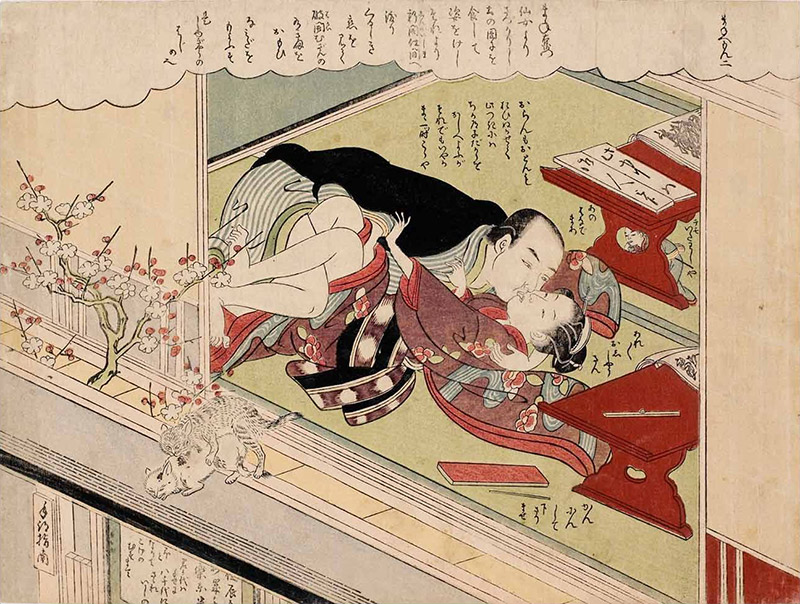
Although plot-driven shunga collections may have been rare, they did exist. At times artists depicted or parodied scenes from the era's popular stories, including The 47 Ronin, Hakkenden: The Dog Warriors and even The Tale of Genji. Screech cites a poem reacting to the eroticization of Genji:
Even Genji
can be poison
to young minds
Jippensha Ikku's travel tale, Tōkaidōchū Hizakurige, inspired a whole series of travel prints by legendary woodblock artist Hiroshige in The Fifty-three Stations of the Toukaidou (Screech). Screech writes, "The entire preface to the book is a series of sexual puns, in this case nanshoku ones."
Some shunga featured limerick-like poems. The British Museum's Tim Clark gives one example from Kitagawa Utamaro's print Poem of the Pillow:
Its beak caught firmly in the clamshell,
the snipe cannot fly away,
on an autumn evening.
Other shunga featured animal puns, helping to excuse animal voyeurs – some more exotic than others. Screech describes one exotic case, "Camels were called rakuda, which sounded like the casual expletive 'raku da!' (feels comfy)."
Even Enma, the lord of hell becomes a victim of parody. In Male Colors: The Construction of Homosexuality in Tokugawa Japan, Gary P. Leupp describes one instance where Enma is so moved by a nanshoku painting that, "he immediately falls in love with the image and, in his excitement, tumbles down from his thrown… The king of hell at once declares his determination to leave the netherworld for Japan, where he will seek out the actor and 'share his pillow" (87).
Encounters of the Unique Kind
But shunga's unique encounters didn't end with camels or King Enma. Japan's colorful array of beasts, monsters and youkai also got in on the act. Screech explains, "Folklore had it that some beasts (including tengu, kappa, even transforming males foxes) kidnapped human males for sexual pleasure."
Once again Hokusai inked the most famous example in The Dream of the Fisherman's Wife, a picture depicting a woman making love with two octopuses in what many consider the birth of "tentacle porn."
Although most early shunga depict consensual encounters, some later examples take a darker tone. "Actual rape becomes a shunga fetish," Screech writes, "either by friends and relatives or by burglars and cut-throats."
Even the human body can morphs and become the aggressor. "In Kunisada's use of the homunculus in his New Tale of the Welling Waters of 1827, Beanman must draw his sword to fight off a monster vagina that threatens to engulf him until, quelled, it surrenders to his bidding" (Screech).
Some of shunga's unique encounters avoided the dark and extraordinary for more inquisitive tones. The limited number of foreigners in Japan sparked curiosity and inspired some artists to depict non-Japanese subjects. Ruth Styles explains, "And while most shunga do focus on ordinary Japanese people, the odd Dutch or Portuguese adventurer sometimes creeps in."
Lasting Influence
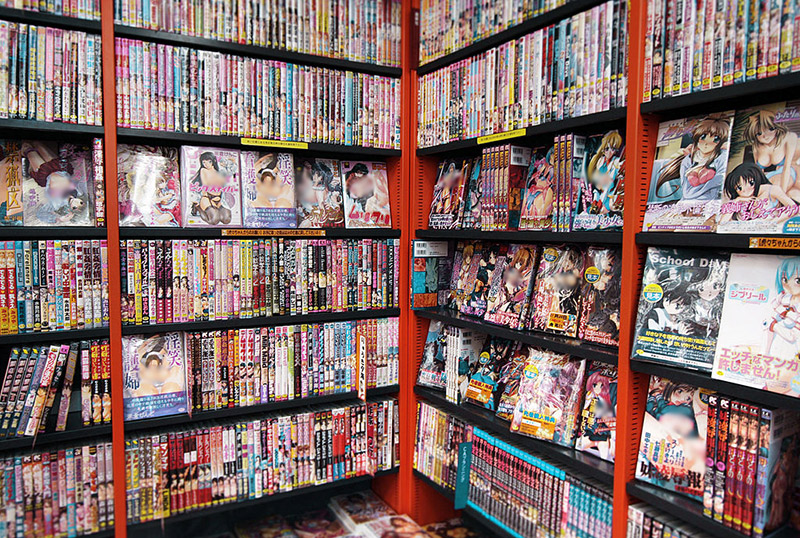
Have shunga left a lasting legacy?
I think I experienced one aspect of it as an innocent youth at the video shop. Ancient shunga prove Japan's interest in pornographic art – be it comics, cartoons or ancient shunga – is nothing new.
Industry giants feel the same way. Luke Malone writes, "Toshio Maeda (widely considered to be the grandfather of erotic manga)… sees (erotic manga) as the modern iteration of an important cultural tradition (i.e. shunga)."
Calling hentai manga a "remnant" of shunga seems like an appropriate description. Perhaps today's tentacle, monster, demon, alien and robot pornography can be traced back to the days of anything-goes erotic prints. Even Japan's lolita and wakashu fetishes might find a root in shunga's younger boy and girl subjects.
But shunga's legacy need not be limited to extremes. Most prints celebrated more subdued themes, like loving sex between consenting adults. And these themes also enjoy continued popularity in Japan's modern erotica. They just don't make headlines.
Perhaps Japan's modern erotic media – including manga, anime, movies, video games – would not be socially acceptable or even legal today if it weren't for the path blazed by Edo era shunga.
Obscenity? Art? Or Both?
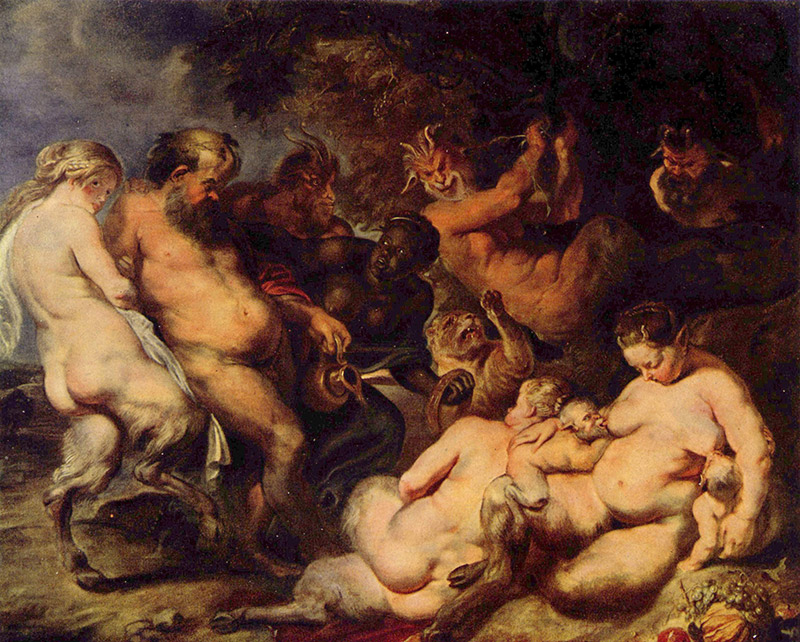
Beauty is in the eye of the beholder and time has been kind to peoples' perceptions of shunga. Many of today's viewers admire the prints as works of art. Distinguished museums in the west, like The British Museum, have held popular exhibitions celebrating the medium.
Yet shunga continue to be considered obscene in Japan, their country of origin.
The recent arrest of the "vagina artist" Megumi Igarashi has helped stoked the debate – what separates art from obscenity? Police arrested Ms. Igarashi, also known as Rokudenashi-ko ("A No-Good Girl"), for distributing 3d data for the replication of her vagina for artistic purposes. The No-Good Girl's art included a "no-good" kayak modeled after her vagina.
She presented her case at a press conference (video presented by The Japan Times):
I was charged with the crime of distributing obscene data… The way that this word, 'obscenity' has been attached to the vagina makes it seem like some remote, unfamiliar object… In Japan there is a tradition of festivals that celebrate sexual organs, and yet we also have this notion of obscenity. I think my arrest was a symptom of this distorted notion of sexuality that exists in this country.
But it wasn't always that way. In fact, Western taboos shaped Japan's attitudes and laws dealing with sex and nudity. In her essay Shunga in the Meji Era: The End of a Tradtion? Rosina Buckland explains, "From 1872 onwards, the government undertook to regulate and control prostitution more strictly, as part of its project to "civilize" Japan in the view of Western nations." Laws banning shunga soon followed.
Despite its reputation for perversion, Japan takes a conservative stance when it comes to sexuality. And although headline making situations exist, they do not represent the norm. Tim Clark remarks, "Somehow ironically, (shunga) are more explicit than today's Japanese pornography laws would allow." Strict laws outlaw displaying genitalia in media – a common element of Edo-era shunga.
In all likelihood, few Edo-era people purchased shunga for their artistic value. During an era devoid of magazines, video, and the internet, shunga represented the equivalent of modern day pornography. So it's understandable that Japanese law considered shunga obscene.
Yet if few people question non-erotic woodblock prints' validity as art, isn't it hypocritical to treat their erotic counterparts differently? After all both use the same method of production and depict imagery popular of the time period.
Is Ms. Igarashi's kayak obscenity or art? Should she have the right to make it and display it? Should fans have the right to see it? Where do we draw the line? And who has the right to answer these questions, particularly when it comes to policies that affect others?
Perhaps American Supreme Court Justice Potter Stewart put it best in the Jacobellis v. Ohio obscenity case when he said, "I know it (obscenity) when I see it." Individuals define obscenity by their own opinions and values – there is no clearcut definition. And as we have seen in the case of shunga, one person's art may be another person's obscenity.
But one fact cannot be denied – art or not, shunga hold value as unique cultural artifacts. And we can learn a lot from these primary sources that offer a peek into Edo era attitudes, interests, people and bedrooms.
One thing's for sure, I'll never look at hentai reading commuters on the train the same way again. I might even sit a little bit closer to them. They are not perverts, but misunderstood, safety-conscious citizens; heroes willing to tarnish their own images to protect themselves and everyone in the vicinity from fire.
